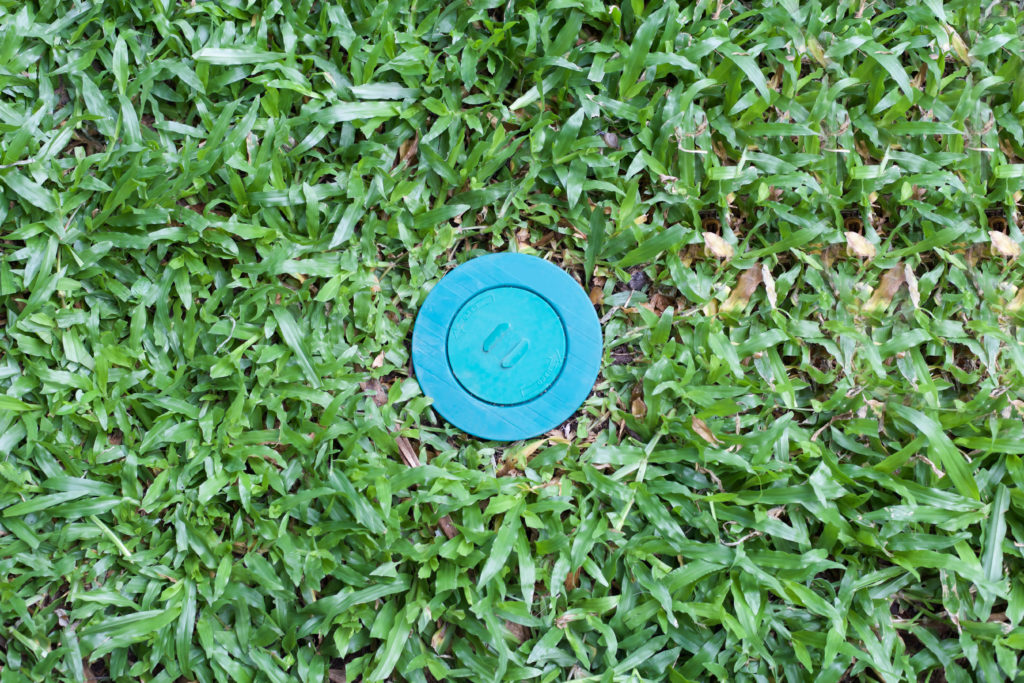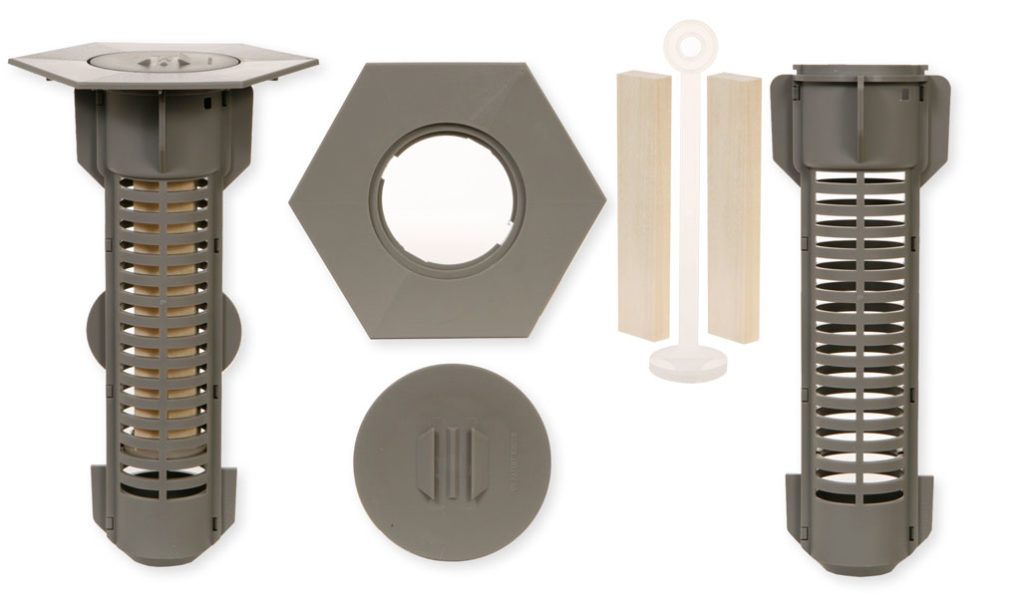Thinking about using termite traps but unsure if they’re right for you?
Good news. Your search for answers stops here.
In this post, we’ll go over everything you need to know about termite traps so you can decide if they are the right solution to your termite woes.
But first, let’s start from the beginning: what are termite traps?
What Are Termite Traps?
Termite traps, a.k.a Termite Stakes, are bait stations designed to eliminate termites.
These stations do not trap termites. Instead, they entice termites to ingest deadly chemicals using bait.
The bait can be anything with cellulose, such as wood and paper.
Termite traps are effective because they are slow-acting.
When worker termites eat them they don’t die right away.
Instead, they return the food to the nest and spread the bait to the entire colony.
Since other members rely on worker termites for food, you only need a few soldiers to feed on the bait to kill a significant amount of the population.
Underground vs Above Ground Bait Traps
There are two types of termite traps: Underground and Above Ground.
Both traps kill termites the same way. But they target different species of termites.
Underground Bait Traps
Underground Termite traps only work on subterranean termites.
That’s because for the bait to work, the termite needs to be able to access it.
Subterranean termites’ nest is located under the soil, so they’ll be able to find the bait.
Drywood termites and Dampwood termites, on the other hand, don’t live underground.
They live deep inside the wood. So, neither Drywood and Dampwood termites won’t come into contact with termite traps or bait stations.
To treat Drywood or Dampwood termites using bait traps, you have to use an above-ground bait station.
Above Ground Bait Traps
The only difference between above ground and below ground bait traps is their placement.
Above ground bait traps involve placing the traps near or on infested wood to draw out the termites.
Once the termites receive the bait, they can take it to the rest of their colony.
Above ground bait traps are designed to attract both Drywood or Dampwood termites.
Are Bait Traps Effective?
Baiting stations have been proven to eliminate two different populations of termites in 67 days or less.
But these traps are only effective if the termites find and consume the bait.
Unfortunately, this precondition diminishes the bait traps’ effectiveness.
When there are other food sources around, there is no guarantee that termites will find the traps.
Plus, the termites will continue to do damage until they find the traps, making bait traps less than ideal.
As such, bait traps are often used alongside other methods such as liquid treatment to eliminate termite infestation.
That said, bait stations work well as a prevention method against termites.
Bait vs. Liquid Treatment
Bait Traps and Liquid treatments are two standard methods used to treat subterranean termites.
Liquid treatment, also known as a soil treatment, involves applying a liquid pesticide under and around the structure.
The liquid, known as a ‘termiticide,’ kills any termites that come in contact or ingest the soil.
The liquid stays active for several years.
As such, liquid treatment is an excellent way to provide a long-lasting chemical ‘barrier’ against termites.
Any termite that attempts to penetrate the treated soil will either be killed or repelled.
While a liquid treatment offers much faster and effective results than bait traps, it’s much more intrusive.
For one, you’ll need to inject large volumes of the termiticide around your home.
You’ll also need to drill holes around your home to inject the liquid.
Pro’s and Con’s of Liquid Treatment
Pro’s
- Very Effective
- Faster Application Process
- Wider Area of Coverage
- Stays active for years
- Long-lasting termite repellant
- Safe for Pets once dry
Con’s
- Expensive
- Intrusive
- Can contaminate nearby water sources such as wells, ponds, or lakes
Pro’s and Con’s of Bait Traps
Pro’s
- Effective if found and consumed
- Easy to install and reapply
- Environment-friendly (Doesn’t contaminate water sources)
- Useful termite detection method
Con’s
- Not effective at eliminating termites on its own
- Takes too long to work
- Require continues inspections
- Not aesthetically pleasing
Benefits of Using Bait Traps
Environment-Friendly
Compared to liquid treatment, bait traps are much less likely to contaminate water sources.
For one, bait systems have relatively low amounts of termiticides.
They are also located inside a container, minimizing the chances of the chemical seeping into water lines.
While the chemical may leak during the rainy season, it’s still much less harmful than liquid treatments.
Easy To Install and Reapply
Termite bait systems are easy to use and monitor.
Unlike liquid treatments, you can employ this method without drilling.
All you need to do is purchase it from the store and plant it in strategic places around your home.
Reapplication is very easy with bait stations.
If you find a bait station that needs the bait replaced simply unlock the lid, remove the old bait and drop the new one it.
Bait cartridges make this extremely quick because there is a handle you can grab and you never need to physically touch the bait.
Once you are finished lock it up and you are ready to go.
Useful Preventative Method
You can use bait systems to detect termite in your home.
To do this, you fill the cylinder with the bait without the termiticide.
If you see termites feeding on it, you’ll know you have termites present in your home. You can then implementing treatment right away.
Are Termite Bait Stations Safe for pets?
Yes. Bait stations are safe for pets.
The lid comes with a lock, so children and pets will not be able to open it.
Once locked, the opening to access the bait is small. Your pet won’t be able to get through it.
Finally, underground bait stations are buried in the ground, making it difficult for your pet to remove and access the bait.
What do termite bait stations look like?

When they are inside the ground, they are a bit hard to notice.
They are usually flush with the ground and look like a drain with a cover over it.

Outside of the ground, Bait stations are small cylinders that enter the ground.
They can look like thick stakes with a void in the middle.
How to install termite bait stations by yourself
1. Gather The Materials Needed
To install termite bait stations, you’ll need:
- Shovel or a post hole digger. Some bait stations will come with a digging tool.
- Bait stations.
- Cellulose. This is typically wood shaving or cardboard.
- Cartridges. Some baits come with cellulose and termiticide, so you wouldn’t have to purchase them separately.
2. Map Out Installation Spots
Determine where around your home you’re going to bury the baits and mark them.
The goal is to surround the perimeter of your home with baits at about 10 to 15 feet increments.
Installing the bait stations at fixed intervals increases the chance of termites finding them.
Place additional bait in other suspect areas such as around moist areas and near previous termite damage.
If your home has been treated with another termiticide, you’ll want to place the baits about 1-2 feet away from the foundation.
Bait stations are typically placed away from the foundation to avoid contamination.
3. Dig Holes on Your Marked Spots
Use a digging tool to create holes deep enough to bury the bait station while leaving the lid accessible on the ground’s surface.
Having easy access to the lid is essential so you can monitor and replenish the bait.
4. Bury The Bait Station
Once the holes are ready, bury the stations into it.
Make sure that the baits are not loose into the ground. If the holes are too big, add some soil to make it snugger.
5. Pre-Baiting
Don’t add termiticide right away.
First, you’ll want to establish the eating habits for the termites.
This process is called pre-baiting.
Pre-baiting allows the scout termite to find and feed on the bait safely.
The scout termite will then leave a scent trail for the worker termites to follow and feed on the bait.
Once you have a feeding cycle between the scout and worker termites, you can proceed to replace the wood with a toxic substance.
The worker termites will then feed on the bait and bring the poison to the entire colony.
How many termite bait stations do I need?
You’ll need about one bait station every 10-15 feet around the perimeter of your home.
Installing the bait stations at fixed intervals increases the chance of termites finding them.
Place additional bait in other suspect areas such as around moist areas and near previous termite damage.
What is a Bait Cartridge?
A bait cartridge is a pre-packaged bait that you place inside the bait station.
You insert it in the void at the center of the bait station.
Bait cartridges have slits around them that allow termites to enter and access the bait inside.
Other than cartridges, you can fill the bait station with cellulose without termiticide to detect termites or for the prebaiting phase.
How Long Does Termite Bait Station Last?
Bait stations should last you a lifetime.
While bait stations can become moldy after several years, the ingredient remains active and effective against termites.
Once you have a bait station, you’ll only need to replenish the bait inside.
How Long Does Termite Bait Last?
Most bait will last over ten years.
But this may vary depending on the termite activity in your area.
Bait stations placed on high activity areas will need to replaced more frequently than areas with less activity.
